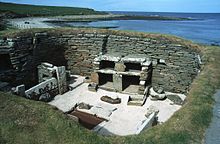Skara Brae
Skara Brae is a Neolithic settlement on Orkney . It is located directly on the west coast of the main island Mainland in Scotland on the Links of Skail . It is dated between 3,100 and 2,500 BC. Dated BC and contained ceramics of the Grooved Ware . The use of Skara Brae ends with the bell beaker culture .
Discovery and excavation
After a violent storm in Scotland that killed over 200 people in 1850, some buildings were discovered under a dune. First, the local landowner Graham Watt, the 7th Laird of Skaill, began investigations on four houses that were discontinued in 1868. The results of the excavation were presented by George Petrie. Excavations by the antiquarian James Farrer remained largely undocumented. Further measures were taken from 1924, when the site was again threatened by storm surges. Between 1928 and 1930 excavations took place under the direction of Gordon Childe of the University of Edinburgh . The settlement was initially ascribed to the Picts and dated to the late Bronze Age. An age determination with the radiocarbon method was carried out in the early 1970s.
meaning
Skara Brae is considered to be the best preserved Neolithic settlement in Europe. Skara Brae is therefore also called the " Pompeii of Scotland". In 1999, Skara Brae was as part of the Heart of Neolithic Orkney by the UNESCO for World Heritage declared.
Houses
The rectangular houses are built of stone, as wood (the normal building material of the Neolithic Age) was rare in the Orkney Islands. The shape of the nine houses is also known from the Rinyo site of the same age and the earlier Barnhouse .
economy
Cattle, sheep or goats and pigs were kept around Skara Brae, barley was grown and, as in the Rinyo of the same time on Rousay , bread was baked. The Arl (a simple plow ) was already known. In addition, the inhabitants lived on game (deer were apparently brought to the islands from the mainland), coastal fishing (cod), oysters , lobsters, mussels and sea birds or their eggs and the secondary products of livestock farming (cheese, milk). A workshop was found in Skara Brae where local stones were processed, for example into Carved Stone Balls , five of which were found there. Finds of hematite made by Hoy indicate that there was an exchange among the islands of the archipelago.
Other finds
The botanist Joseph Banks excavated graves at the Links of Skail in 1772.
Trivia
- In some episodes of the role-playing epic Ultima , Skara Brae is an independent island west of the main country "Britannia".
- In the computer role-playing game The Bard's Tale , Skara Brae, set in a hypothetical Middle Ages, is the main setting.
- The name also refers to a former traditional Irish folklore band of the 70s, which was active between 1970 and 1971 and released a single album with songs in Irish.
- In the movie Indiana Jones and the Kingdom of the Crystal Skull , Professor Indiana Jones teaches an archeology class on Skara Brae.
literature
- V. Gordon Childe : Skara Brae. A Pictish Village in Orkney. Kegan Paul et al., London 1931.
- V. Gordon Childe: Ancient dwellings at Skara Brae. Her Majesty's Stationery Office, Edinburgh 1950.
- David Clarke: Excavations at Skara Brae, a summary report. In: Colin Burgess, Roger Miket (Ed.): Settlement and economy in the Third and Second Millennia BC Papers delivered at a conference organized by the Department of Adult Education, University of Newcastle upon Tyne, January 1976 (= British Archaeological Reports 33) . British Archaeological Reports, Oxford 1976, ISBN 0-904531-52-X , pp. 233-250.
- David Clarke, Patrick Maguire: Skara Brae. Northern Europe's best preserved prehistoric village. Historic Scotland, Edinburgh 1989, ISBN 0-7480-0190-5 (also: ibid. 2000, ISBN 1-900168-97-9 ).
Stone balls
- Dorothy N. Marshall: Further notes on carved stone balls. In: Proceedings of the Society of Antiquaries of Scotland. Vol. 113, 1983, ISSN 0081-1564 , pp. 628-630 .
- Dorothy N. Marshall: Carved stone balls. In: Proceedings of the Society of Antiquaries of Scotland. Vol. 108, 1976/1977, pp. 40-72 .
- Ludovic MacLellan Mann: The Carved Stone Balls of Scotland: A New Theory as to their Use. In: Proceedings of the Society of Antiquaries of Scotland. Vol. 48, 1913/1914, pp. 407-420 .
Single receipts
- ^ Bryson, Bill (2010): At home: a short history of private life. London-New York: Doubleday. ISBN 978-0-385-60827-5
- ^ Virginia Zimmermann, Storm and Stone: Accidental Archeology at Skara Brae in Orkney. Victorian Review 40/2, (14), 39. Stable URL: https://www.jstor.org/stable/24877712
- ↑ George Petrie, Notice of Ruins of Ancient Dwellings at Skara, Bay of Skaill, in the Parish of Sandwick, Orkney, Recently Excavated. Proceedings of the Society of Antiquaries of Scotland 7, 1867.
- ^ Reginald A. Smith, The Skara Brae Village in Orkney. The British Museum Quarterly 7/4, 1933, 128. Stable URL: https://www.jstor.org/stable/4421489
- ↑ http://www.orkneyjar.com/history/skarabrae English website
- ↑ Jacquetta Hawkes (1986): The Shell Guide to British Archeology. London: Michael Joseph. ISBN 0-7181-2448-0 , page 2
- ^ Averil M. Lysaght, Joseph Banks at Skara Brae and Stennis, Orkney, 1772. Notes and Records of the Royal Society of London 28/2, 1974, 221-234. Stable URL: https://www.jstor.org/stable/531332
Web links
Coordinates: 59 ° 2 ′ 55 " N , 3 ° 20 ′ 35" W.

